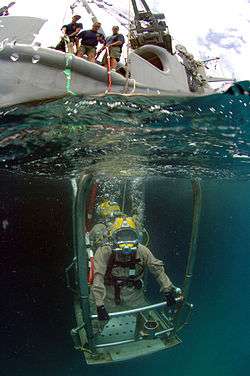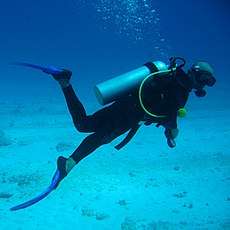Clearance diver

_2_perform_diving_operations_to_raise_a_mine_off_the_ocean_floor_during_a_scenario_for_Frontier_Sentinel.jpg)
A clearance diver was originally a specialist naval diver who used explosives underwater to remove obstructions to make harbours and shipping channels safe to navigate, but later the term "clearance diver" was used to include other naval underwater work. Units of clearance divers were first formed during and after the Second World War to clear ports and harbours in the Mediterranean and Northern Europe of unexploded ordnance and shipwrecks and booby traps laid by the Germans.
In some navies, including Britain's Royal Navy (RN), work divers, which includes ship's divers, must have a line and a linesman when possible.
History
The first units were Royal Navy Mine and Bomb Disposal Units. They were succeeded by the "Port Clearance Parties" (P Parties). The first operations by P Parties included clearing away the debris of unexploded ammunition left during the Normandy Invasion. Six groups of Clearance Divers including Commonwealth and European allied forces were in operation by 1945.
Naval work diver training is much longer and harder than sport diver training and has much stricter entry requirements.
For a long time navies used the heavy standard diving dress for underwater work. During and after World War II some of them started using frogman-type gear when frogman's kit became available. Later they started often using open-circuit scuba gear for work diving.
Nations with naval work diving groups
_divers.jpg)
Australia
The Royal Australian Navy Clearance Diving Branch clearance divers also serve as combat divers.
France
The French Navy clearance divers are known as plongeurs démineurs [1]. The French Army has clearance divers as well named plongeurs de combat du génie[2]. To avoid redundancy, they only operate in freshwater environments. Although they are trained in demolition and explosives clearance, they also survey banks and possible crossing areas, and may make offensive interventions.
New Zealand
The Royal New Zealand Navy Operational Diving Team (ODT) are clearance divers and also serve as combat divers.
North America
- Canada: Canadian armed forces divers
- US: Underwater Demolition Team - US Navy, 1943–1967
Mainland Europe
- Estonia: EOD Tuukrigrupp (EOD Clearance Diver UNIT)
- France: France's Clearance Divers are called the Plongeurs Démineurs (link in French).
- Germany: Minentaucher is Germany's Clearance Diver force.
- Ireland (Republic of): Naval Service Diving Section (NSDS).
- Lithuania: EOD Diving unit
- Norway: Minedykkerkommandoen Norway's naval work divers and Clearance Diver force, "Norwegian Naval EOD commando".
- Portugal: the Sapper Divers Group, which also serve as combat divers unit.
- Sweden: Swedish Navy EOD division
United Kingdom
British Royal Navy naval work divers are officially called Clearance Divers.[3]
During WWII they at first often used the Davis Submerged Escape Apparatus and no diving suit, and no swimfins and they swam by breaststroke.
On 1942 December 17 (ref. Decima Flottiglia MAS#1942), 6 Italians on three manned torpedoes attacked Gibraltar harbor. A British patrol boat killed one torpedo's crew (Lt. Visintini and Petty Officer Magro) with a depth charge. Their bodies were recovered, and their swimfins were taken and used by two of Gibraltar's British guard divers (who dived with Davis Escape Sets and (up to here) breaststroke swimming and no fins) (Sydney Knowles and Commander Lionel Crabb). This was the first known British frogman use of swimfins, rather than a Sladen suit and weighted boots riding a Chariot.
In 1944 November in Livorno in Italy an Italian frogman called Vago came over and joined the British frogman team and brought them two Decima Flottiglia MAS issue oxygen rebreathers, which proved better in use than the Davis Submerged Escape Apparatus and lasted longer on a dive. He also brought them an Italian light 2-piece frogman's drysuit: before then they dived with their skin exposed.[4]
For many years Clearance Divers used the Siebe Gorman CDBA rebreather.[5][6]
In 1982 Clearance Divers were heavily involved in the Falklands War, in which Britain recaptured the Falkland Islands from Argentina. They received many awards and medals for their work on mines and disposing of 1000-pound bombs lodged in British warships.[7]
In the 1990s they used a type of automatic mixture rebreather which is so heavy that on surfacing after a dive even a very physically fit naval diver preferred to remove the rebreather while still in the water and have it craned out separately.
Other combinations of kit used in the past by British Clearance Divers (work divers) were:
- Sladen suit and weighted boots and Siebe Gorman Salvus.
- Sladen suit and weighted boots and aqualung. According to a 1950s British naval diving manual, this was the only approved way to use the aqualung.
Presently, the Royal Navy's elite Clearance diving branch is made up of a number of diving teams and clearance diving elements, that serve aboard mine hunters as part of the ships weapons system. The core of the "branch", as it is referred to by its members is made up of the following land based diving units:
Southern Diving Units 1 and 2 and Northern Diving group.
These units provide 24/7 domestic bomb and mine disposal and IED disposal cover. SDU1 covers the South West of the UK. SDU2 covers the South East of the UK, and Northern diving group covers the North, including Scotland and Northern Ireland. The units operate exactly like their counterparts from the Army, with the added skill set of being able to deal with water based munitions.
Fleet Diving Group, made up of Fleet Diving Units 1, 2 and 3.
Each unit requires new members to undergo further training depending on the specialisation of the unit they're joining.
FDU1 provides an elite team of Clearance Divers that works alongside UK Special Forces (UKSF). New members are trained in Parachuting, maritime counter terrorism (MCT) tactics and SDV operations.
FDU2 comes under 3 Commando Brigade, and specialises in Very Shallow Water (VSW) beach reconnaissance operations. New members to FDU2 receive further training in VSW operations tactics. They are also required to complete additional weapons training, and Survival Evasion Resistance and Extraction (SERE) training that culminates in a resistance to interrogation phase. Members of FDU2 train and work regularly with other specialist elements from the UK and foreign militaries.
FDU3 are the deep water warfare unit and specialise in dealing with modern enemy sea mines. FDU3 members will also regularly cross train with FDU2 and receive the same additional training as their team 2 colleagues.
Throughout their careers Clearance Divers will serve on a number of, if not all of the diving units within the branch, gaining a wide range of experience to take from team to team. Clearance divers have been involved in every major British conflict since their inception and have most recently deployed teams to Iraq, Afghanistan and Libya. They have units operating permanently in the Middle East and have continuously provided an Underwater Force Protection (UWFP) element since the September 11 attacks.
Training to become a Clearance Diver is notoriously arduous and lasts around 7 months. The course has been known to have a 100% failure rate in the past, though usually around 40% of trainees will make it successfully through to the end.
Before prospective trainees are accepted onto a course, they must pass a week-long diving aptitude selection, held at the Defence Diving School, on Horsea Island, Portsmouth. This selection involves first of all passing the Divers Physical Fitness Test (DPFT) on day one. The rest of the week then involves numerous tests of physical and mental endurance, including circuits, mud runs and surface swimming. The candidates are also introduced to the Royal Navy's Swimmers Air Breahting Apparatus (SABA) set, and complete numerous dives in Horsea lake, including night dives in low to zero visibility. Those that make it are then put into a pool of candidates and will be given a course start date. Due to the large physical and mental pressures brought on by military diving, the failure rate on the aptitude has been historically high. Owing to this high attrition rate the branch started a three-day Pre Entry Diving Acquaint (PEDA), which allowed civilian candidates to attend Horsea Island and undergo physical and mental tests to give them a better idea of the training that lay ahead of them before they had actually joined the Royal Navy.
See also
- US military divers
- US Navy diver
- US Navy EOD
- Frogman; someone who is trained as a combat diver.
| Wikimedia Commons has media related to Clearance diving. |
References
- ↑ https://www.lemonde.fr/campus/article/2016/12/11/plongeurs-demineurs-l-elite-des-grands-fonds_5047083_4401467.html
- ↑ https://www.ladepeche.fr/article/2017/03/29/2545812-phase-tests-entrer-parmi-elite-plongeurs-combats-genie.html
- ↑ http://www.mcdoa.org.uk/RN_Clearance_Diving_Branch.htm
- ↑ pp 16-20, issue 41, Historical Diving Times, ISSN 1368-0390
- ↑ Quick, D. (1970). "A History Of Closed Circuit Oxygen Underwater Breathing Apparatus". Royal Australian Navy, School of Underwater Medicine. RANSUM-1-70. Retrieved 2009-03-20.
- ↑ Goble, Steve (2003). "Rebreathers". South Pacific Underwater Medicine Society Journal. 33 (2): 98–102. Retrieved 2009-03-20.
- ↑ https://www.amazon.co.uk/Diver-Tony-Groom/dp/1906266069 Book description: Clearance Diving in the Royal Navy, including their work during the Falklands war.

